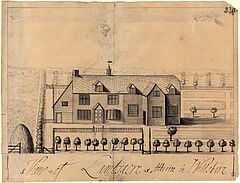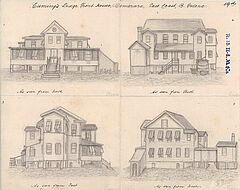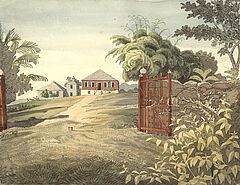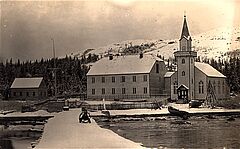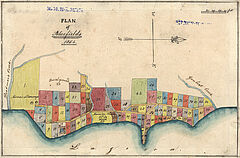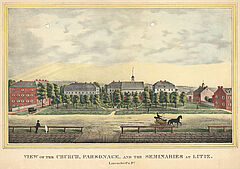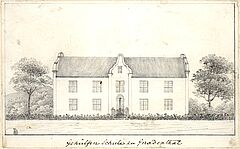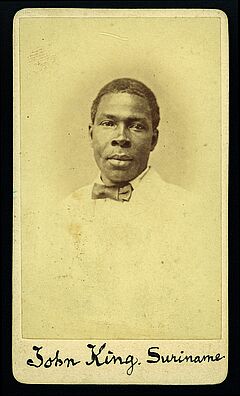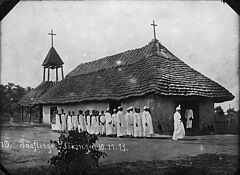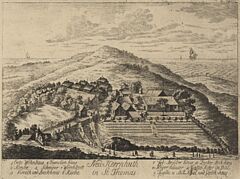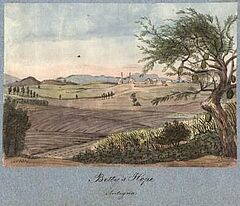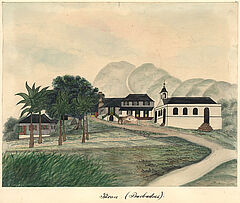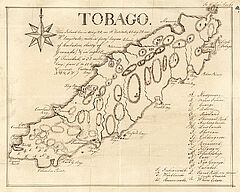Holdings about the Unity Provinces and the Mission Provinces of the worldwide Moravian Church
The Unity Province Alaska
The Moravian Church began the mission in Alaska in 1885, after the Society of Promoting the Gospel in Bethlehem/Pa., had received an invitation from the Presbyterian minister Sheldon Jackson in 1883. It was the first new mission project of the Moravian Church, in which a specific province and its mission society took the lead and had full responsibility. The Mission Department of the Unity Elder's Conference in Berthelsdorf, which up to this point had been the coordinating board for all activities, now had only a supervisory role. This fact is reflected in the records collection in the Unity Archives: while most of the the official correspondence was conducted between the missionaries in Alaska and Bethlehem/Pa. only copies of important letters and other papers, together with reports from the SPG, were sent to the mission boards in Berthelsdorf or Herrnhut. The only exceptions are some personal letters of the German-speaking missionaries. The papers relating to the Alaska Mission are included in the online research materials of the Unity Archives (www.unitaetsarchiv.findbuch.net) and are divided into two main record groups, according to the history of the administration of the Moravian Mission: The records of the Mission Department of the Unity Elder's Conference (record group: R.15.W, term: 1887 - 1908) consists primarily of annual reports from the congregations of Bethel, Carmel, Ogavik (Uknavik) and Quinhagak, and a series of correspondence between the Mission Department in Berthelsdorf and the president of the Alaska Mission, as well as with the Provincial Elder's Conference in Bethlehem/Pa. and with the congregations in Alaska. The synod of 1899 dissolved the Unity Elder's Conference and replaced its Mission Department with a new authority, the Mission Directorate (Missions-Direktion = MD), which remained the supervisory board for the worldwide Moravian Mission until 1931. The collections pertaining to Alaska until 1940 are included in the record group MD and consist of the same kind of records as in the older collection: annual reports and correspondence, along with some statistical data.
The Mission Province Burundi
The missionary work in the provinces and mission provinces of Honduras, Costa Rica, Zambia, Cuba, Congo, Malawi and Burundi began in the period after the dissolution of the central mission society of the Unitas Fratrum (Mission-Direction) in 1931 - from this point on, individual missionary societies in the provinces were responsible for founding new works, which over time led to the development of new mission provinces and independent provinces of the Unitas Fratrum. One consequence of this development was that the Unity Archive no longer built its own record groups for the newer provinces. Instead, documents of the period after 1931 can only be found in the record groups of the church boards of the two districts: of Herrnhut (record groups: MD, then DEBU) and the district of Bad Boll or the Herrnhuter Missionshilfe (record group: EFUD). In particular, the Herrnhuter Missionshilfe has built up an extensive image archive over the years, the analogue part of it has been transferred to the Unity Archive. This collection is to be cataloged and digitized in the coming years.
The Unity Province Costa Rica
The missionary work in the provinces and mission provinces of Honduras, Costa Rica, Zambia, Cuba, Congo, Malawi and Burundi began in the period after the dissolution of the central mission society of the Unitas Fratrum (Mission-Direction) in 1931 - from this point on, individual missionary societies in the provinces were responsible for founding new works, which over time led to the development of new mission provinces and independent provinces of the Unitas Fratrum. One consequence of this development was that the Unity Archive no longer built its own record groups for the newer provinces. Instead, documents of the period after 1931 can only be found in the record groups of the church boards of the two districts: of Herrnhut (record groups: MD, then DEBU) and the district of Bad Boll or the Herrnhuter Missionshilfe (record group: EFUD). In particular, the Herrnhuter Missionshilfe has built up an extensive image archive over the years, the analogue part of it has been transferred to the Unity Archive. This collection is to be cataloged and digitized in the coming years.
European Continental Province of the Moravian Church
A large part of the Unity Archives entire holdings is made up of the record groups concerning the present-day European Continental Province. All the documents and collections created during the Zinzendorf period (1722–1760) as well as during the time of the central administration (1760–1900) were categorised variously in the archive according to content: records of the Synods (R.2), of the Central Church Board (R.3), records concerning individual congregations (R.6–R.12, R.27) and the so-called diaspora work within Europe (R.19), records concerning the large number of schools (R.4), and records of the financial and legal departments (R.1, R.5, UVC). The archivists also made collections with different content, among which the most important is the collection of memoirs (R.22).
All the documents from the period after 1900 are contained in large provenance holdings and belong to the Provincial Archives of the European Continental Province. These are the documents of the Provincial Synods (DSyn) and the extensive records of the Provincial Board (DUD) for the period from 1900 to 1945. After the Second World War, due to the division of Germany into two states, two record groups were created in the two districts of the province that existed in parallel: the Synod (SynHt) and the Provincial Board (DEBU) of the Herrnhut District (GDR) and the Synod (SynBB) and the Provincial Board (EFUD) of the Bad Boll District (concerning the other parts of the European Continental Province). Since 1992 and the unification of the two districts the records that have already been submitted to the Provincial Archives are summarized in the record group with the abbreviation EBU.
In addition to these administrative documents from the Synods and Provincial Boards, there are a large number of archives incorporated from congregations, various institutions and businesses of the Province, which ended up in the Unity Archives after their dissolution. Supplementary documents and objects can be found in the various collections: Photographs, Musical Manuscripts, Paintings (GS), Objects (M and ES) and in the Topographical Collection (TS), which contains a large number of illustrations, maps, and plans. Most of these record groups can be researched using our online searching aids.
The British Province
After the General Synod of 1857 had decided to grant greater independence to the Moravians in Great Britain and Ireland, the jurisdiction of the Unity Elder's Conference in Berthelsdorf of this region came to an end, as did that of the Unity Archives. For the period dating from the first contacts to London in the 1730s up to 1857, however, there is a large number of records primarily gathered in the historical record group R.13. These include a variety of records and collections concerning the various contacts of Zinzendorf and his staff with many figures in the British public sphere, the negotiations in the British Parliament, different plans for settlements in the country, etc. The serial records contain diaries of and correspondence with all the congregations in England, Ireland, and Scotland; minutes from the Helper's Conferences and regional synods; and copies of church records. Supplementary documents can be found in the record groups concerning the mission (R.15, MD, MDF), since London was an important base for the Moravian Church's missionary enterprise, as well as in the Topographical Collection (TS), which contains a large number of illustrations, maps, and plans. All of these record groups can be researched using our online finding aids: www.unitaetsarchiv.findbuch.net.
The Unity Province Guyana
The Co-operative Republic of Guyana is located on the northeastern coast of South America and is the western neighboring country of Suriname. On today's territory - previously known as Berbice, which belonged to the Netherlands - there was the ›Pilgerhut‹ station, founded in 1740, which existed for about 23 years. In 1815 the region became British and the next attempt to establish a mission by the Moravian Church began after the proclamation of the Abolition of Slavery in the British colonies in 1835. John and Anna Elisabeth Colemann were the first missionaries, followed by Adam and Rebekka Hamann. The attempt was stopped after 5 years - although it was not without success - and it was not until 1878 that a new start with three missionaries from Barbados was made. The small, resulting record group was maintained in the Unity Archives in a separate record group. The records from the period 1834-1908 are in the inventory of the Mission-Department of the Unity Elder's Conference (R.15.H.III.), while records from the period 1908-1931 are kept in the inventory of the Mission-Direction (record group MD - Demerara (Guyana)). Records pertaining to financial management are in the record group MDF. In addition to a small collection of documents from the early days of the mission in Guyana, the inventories mainly contain serial files: reports, correspondence, and accounting documents. All these record groups can be researched using our online searching aids: www.unitaetsarchiv.findbuch.net.
The Unity Province and the Mission Province Honduras
The missionary work in the provinces and mission provinces of Honduras, Costa Rica, Zambia, Cuba, Congo, Malawi and Burundi began in the period after the dissolution of the central mission society of the Unitas Fratrum (Mission-Direction) in 1931 - from this point on, individual missionary societies in the provinces were responsible for founding new works, which over time led to the development of new mission provinces and independent provinces of the Unitas Fratrum. One consequence of this development was that the Unity Archive no longer built its own record groups for the newer provinces. Instead, documents of the period after 1931 can only be found in the record groups of the church boards of the two districts: of Herrnhut (record groups: MD, then DEBU) and the district of Bad Boll or the Herrnhuter Missionshilfe (record group: EFUD). In particular, the Herrnhuter Missionshilfe has built up an extensive image archive over the years, the analogue part of it has been transferred to the Unity Archive. This collection is to be cataloged and digitized in the coming years.
The Unity Province Jamaica and Cayman Islands
The missionary work of the Unitas Fratrum in Jamaica began in 1754 after two British plantation owners, who had contacts with Zinzendorf in London, had invited missionaries to work on their land in Jamaica. Under the direction of Zacharias Georg Caries, the mission station of Carmel was founded near the plantation The Bogue. The Unity Archives' records concerning Jamaica are for the period 1754-1900 in the inventory of the Mission-Department of the Unity Elder's Conference (record group R.15), for the period 1900-1931 in the inventory of the Mission-Direction (record group MD). Records pertaining to financial management are in the record group MDF. In addition to some documents from the early days of the mission in Jamaica, the inventories mainly contain serial files: diaries, minutes, correspondence, annual reports, accounting documents. Among the valuable diaries are the private diary of Zacharias Georg Caries, the diaries of the individual mission stations or congregations (such as Carmel, Mesopotamia, The Bogue, Island Estate, Aberdeen, Beaufort, Bethabara, Patricktown, Bethany, Cariesbrook, Dober, New Eden, New Fairfield, Fulnek, New Hope, Salem, Irwinhill, Lititz, Ballards Valley, Mizpah, Broadleaf, Springfield, and many others), as well as an even larger number of missionary travel diaries. Interesting supplementary documents may be found in the Topographical Collection (TS), which contains a large number of illustrations, maps, and plans. All of these record groups can be researched using our online searching aids: www.unitaetsarchiv.findbuch.net.
The Unity Province Congo
The missionary work in the provinces and mission provinces of Honduras, Costa Rica, Zambia, Cuba, Congo, Malawi and Burundi began in the period after the dissolution of the central mission society of the Unitas Fratrum (Mission-Direction) in 1931 - from this point on, individual missionary societies in the provinces were responsible for founding new works, which over time led to the development of new mission provinces and independent provinces of the Unitas Fratrum. One consequence of this development was that the Unity Archive no longer built its own record groups for the newer provinces. Instead, documents of the period after 1931 can only be found in the record groups of the church boards of the two districts: of Herrnhut (record groups: MD, then DEBU) and the district of Bad Boll or the Herrnhuter Missionshilfe (record group: EFUD). In particular, the Herrnhuter Missionshilfe has built up an extensive image archive over the years, the analogue part of it has been transferred to the Unity Archive. This collection is to be cataloged and digitized in the coming years.
The Mission Province Cuba
The missionary work in the provinces and mission provinces of Honduras, Costa Rica, Zambia, Cuba, Congo, Malawi and Burundi began in the period after the dissolution of the central mission society of the Unitas Fratrum (Mission-Direction) in 1931 - from this point on, individual missionary societies in the provinces were responsible for founding new works, which over time led to the development of new mission provinces and independent provinces of the Unitas Fratrum. One consequence of this development was that the Unity Archive no longer built its own record groups for the newer provinces. Instead, documents of the period after 1931 can only be found in the record groups of the church boards of the two districts: of Herrnhut (record groups: MD, then DEBU) and the district of Bad Boll or the Herrnhuter Missionshilfe (record group: EFUD). In particular, the Herrnhuter Missionshilfe has built up an extensive image archive over the years, the analogue part of it has been transferred to the Unity Archive. This collection is to be cataloged and digitized in the coming years.
The Mission Province Newfoundland and Labrador
The congregations of the Labrador Province of the Moravian Church are situated along the northeastern coast of the Labrador Peninsula within the Canadian Province of Newfoundland and Labrador. Although four Moravian missionaries explored a place at the coast of Labrador for the first time in 1752, only the second official attempt from 1770 could establish itself as a permanent work in Labrador. In 1771 the first mission station was founded, called Nain, followed by Okak (1776), Hoffenthal (1782) and others. The Unity Archives' records concerning Labrador are for the period 1750-1900 in the inventory of the Mission-Department of the Unity Elder's Conference (record group R.15), for the period 1900-1931 in the inventory of the Mission-Direction (record group MD). Records pertaining to financial management are in the record group MDF. In addition to some documents from the first attempt, the journeys of Jens Haven and Lorenz Drachardt and the beginning of the mission after 1770, the inventories mainly contain serial files: diaries, minutes, correspondence, annual reports, and accounting documents. Among the diaries are those of the individual mission stations or congregations (such as Nain, Okak, Hoffenthal, Hebron, Zoar, Rama, Killinek, Makkovik). Okak's diary is the original copy because the station was closed after the Spanish flu pandemic in 1919. Interesting supplementary documents may be found in the Topographical Collection (TS), which contains illustrations, maps, and plans, and in the collection of photographs. All these record groups (except the collection of photographs) can be researched using our online searching aids: www.unitaetsarchiv.findbuch.net.
The Unity Province Malawi
The missionary work in the provinces and mission provinces of Honduras, Costa Rica, Zambia, Cuba, Congo, Malawi and Burundi began in the period after the dissolution of the central mission society of the Unitas Fratrum (Mission-Direction) in 1931 - from this point on, individual missionary societies in the provinces were responsible for founding new works, which over time led to the development of new mission provinces and independent provinces of the Unitas Fratrum. One consequence of this development was that the Unity Archive no longer built its own record groups for the newer provinces. Instead, documents of the period after 1931 can only be found in the record groups of the church boards of the two districts: of Herrnhut (record groups: MD, then DEBU) and the district of Bad Boll or the Herrnhuter Missionshilfe (record group: EFUD). In particular, the Herrnhuter Missionshilfe has built up an extensive image archive over the years, the analogue part of it has been transferred to the Unity Archive. This collection is to be cataloged and digitized in the coming years.
The Unity Province Nicaragua
For the Moravian Church, the beginning of missionary work on the Miskito coast, the eastern coast of today's Nicaragua, was the first nineteenth-century mission project ever. The idea for this project was not their own, but had been brought to the Unity Elders' Conference by the Saxon Prince Otto Victor I. von Schönburg-Waldenburg. In 1848, the first missionaries, Heinrich Gottlob Pfeiffer, Johannes Eugen Lundberg and Ernst Kandler traveled from Jamaica to Bluefields on the Miskito coast and began their work. The relatively small resulting record group in the Unity Archives was maintained in a separate record group. The records for the period 1846-1908 are in the inventory of the Mission-Department of the Unity Elder's Conference (as R.15.H.II), while records for the period 1908-1931 are in the inventory of the Mission-Direction (record group MD - Nikaragua). Records pertaining to financial management are in the record group MDF. In addition, there are maps and plans in the Topographic Collection (TS) and a large series of photographs in the collection of the "Lichtbildstelle der Mission" (LBS). The inventories of the records mainly contain serial files: diaries, minutes, correspondence, annual reports, and accounting documents. Among the diaries are those of the individual mission stations or congregations (such as Bluefields, Magdala, Rama, Ephrata, Joppe, and many more). All these record groups (except the collection of photographs) can be researched using our online searching aids (www.unitaetsarchiv.findbuch.net).
Two Unity Provinces in North America
The Northern Province
The history of the Moravian contact with North America began in 1733 with plans by Nikolaus Ludwig von Zinzendorf to establish a settlement in the new colony of Georgia. After its founding in Savannah in April 1735 and the beginning of missionary work among Native Americans, slaves and German settlers, it was Pennsylvania in the end, which became the new centre of the Moravian church in North America from 1740. As was the case in Georgia, the Moravians had various aims in mind for this area: establishing contacts between Christian settlers from Europe, the settlement of Moravians, and the missionary work among the Indigenous population. Zinzendorf's stay between November 1741 and January 1743 strengthened these three trajectories and led, among other things, to the foundation of the congregation in Bethlehem, which was to develop into the centre of the Moravian Church in North America.
After the General Synod of 1857 had decided to grant greater independence to the Moravians in North America, the responsibilities there of the Unity Elder’s Conference in Berthelsdorf, as well as that of the Unity Archives, came to an end. For the period dating from the first negotiations with the trustees of Georgia and the establishment of the work in Pennsylvania up to 1857, however, there are a large number of records primarily gathered in the historical record group R.14.A. These include a variety of records and collections concerning the beginning of the work in Georgia and Pennsylvania, the founding and organization of the new settlements, etc. The serial records contain travel diaries, diaries of and correspondence with the congregational settlements in Pennsylvania (Nazareth, Bethlehem, Lititz), and of the large number of so called town- and country-congregations (Philadelphia, Lancaster, Oley, Heidelberg, Yorktown, Donegal, Emmaus, Schoeneck, Hope); minutes from the Helper’s Conferences and regional synods; and copies of church records. Supplementary documents can be found in the record groups concerning the financial administration (UVC) as well as in the Topographical Collection (TS), which contains a large number of illustrations, maps, and plans. All of these record groups can be researched using our online search tools.
The Southern Province
The history of the Southern Province of the Moravian Church in North America started with an exploration party of Moravians and surveyors to the backcountry of North Carolina led by August Gottlieb Spangenberg. John Carteret, the Earl of Granville (1690–1763), offered to sell the Moravians 100,000 acres of land from his real estate holdings in the Carolinas. At the end of 1752, the group finally arrived at a suitable site where a total of 98,985 acres had been surveyed off, and Spangenberg named the tract »Wachovia«. The deeds to the land were signed in London on August 7, 1753, and two months later, on October 8, 1753, the first colony of Brethren set out from Bethlehem, Pennsylvania and founded the first settlement (Bethabara) on November 17, 1753. With the establishment of additional congregations, Wachovia became the Moravians’ second center in North America after Pennsylvania. Salem, founded in 1766, became Wachovia’s central administrative community.
After the General Synod of 1857 had decided to grant greater independence to the Moravians in North America, the responsibilities there of the Unity Elder’s Conference in Berthelsdorf, as well as that of the Unity Archives, came to an end. For the period dating from the first contacts with the Earl of Granville up to 1857, however, there are a large number of records primarily gathered in the historical record group R.14.B. These include a variety of records and collections concerning the beginning of the work in North Carolina, the founding and organization of the new settlements, etc. The serial records contain diaries of and correspondence with all the congregations in Wachovia (Bethabara, Bethania, Salem, Friedberg, Hope, Friedland); minutes from the Helper’s Conferences and regional synods; and copies of church records. Supplementary documents can be found in the record groups concerning the financial administration (UVC) – for example, copies of the original land deeds – as well as in the Topographical Collection (TS), which contains a large number of illustrations, maps, and plans. All of these record groups can be researched using our online search tools.
The Unity Province Zambia
The missionary work in the provinces and mission provinces of Honduras, Costa Rica, Zambia, Cuba, Congo, Malawi and Burundi began in the period after the dissolution of the central mission society of the Unitas Fratrum (Mission-Direction) in 1931 - from this point on, individual missionary societies in the provinces were responsible for founding new works, which over time led to the development of new mission provinces and independent provinces of the Unitas Fratrum. One consequence of this development was that the Unity Archive no longer built its own record groups for the newer provinces. Instead, documents of the period after 1931 can only be found in the record groups of the church boards of the two districts: of Herrnhut (record groups: MD, then DEBU) and the district of Bad Boll or the Herrnhuter Missionshilfe (record group: EFUD). In particular, the Herrnhuter Missionshilfe has built up an extensive image archive over the years, the analogue part of it has been transferred to the Unity Archive. This collection is to be cataloged and digitized in the coming years.
The Unity Province South Africa
The missionary work of the Moravian Church in the area of the present-day republic of South Africa began with only one Brother, the famous Georg Schmidt (1709-1785). Schmidt was originally a butcher and was born in Moravia. In 1737 he made the journey to the Cape area all alone, and worked there under difficult circumstances but with success. Schmidt founded the first settlement in the region of Baviaanskloof, which was later called Genadendal. Finally he returned to Europe in 1744. After this first important attempt, the General Synod of 1789 decided to make a second attempt, and in 1792 Hendrik Marsfeld, Daniel Schwinn and Christian Kühnel reestablished the mission work of the Moravian Church. After the division into two areas in 1869, the western area became a church province of the Moravian Church in 1960, and in 1977 the Unity Conference confirmed the union of the two areas under one roof: the Moravian Church in South Africa.
The Unity Archives' records concerning South Africa are for the period 1737-1900 in the inventory of the Mission-Department of the Unity Elder's Conference (record group R.15.M), for the period from 1900 to the 1940s in the inventory of the Mission-Direction (record group MD). The record groups contain the significant documents from the beginning, for example Georg Schmidt's diaries and correspondence. In addition to these documents from the early days of the mission, the inventories mainly contain serial files: diaries, minutes, correspondence, annual reports, accounting documents. Among the diaries are the travel diaries of various missionaries and the diaries of the individual mission stations or congregations (such as Genadendal, Berea, Capetown, Clarkson, Elim, Enon, Mamre, Pella, Emtumasi, Elukolweni, Engotini, Mvenyane, Gosen, Silo, Tinana and many more). For the period after the Second World War, the records concerning South Africa belong to the Moravian Mission Society (Herrnhuter Missionshilfe e.V. [HMH]) and to the Church Board of the Continental Province of the Moravian Church, Bad Boll District. They are combined in the record Group EFUD and document the manifold ongoing connections with the two regions as well as their development towards independent status and their existence as an independent province. A second large number of records pertaining to the financial management of the mission are in the record group MDF. A third important group of documents belongs to the library’s manuscript collection (NB.VII.R.2 and 3): translations of biblical and liturgical texts, dictionaries, grammars, and hymn books. Interesting supplementary documents may be found in the Topographical Collection (TS), which contains illustrations, maps, and plans, as well as in the collection of photographs (LBS). All these record groups (except for the library and EFUF) can be researched using our online searching aids: www.unitaetsarchiv.findbuch.net. The large collection of photographs is accessible through the International Mission Photography Archive (IMPA) https://digitallibrary.usc.edu/.
The Unity Province Suriname
The mission of the Moravian Church in the area of the present-day republics of Suriname and Guyana began in 1735 with the sending of three Moravian brothers—Georg Piesch, Georg Berwig and Christoph von Larisch—to the former Dutch colonies on the northeast coast of South America. Von Larisch died after only a month and a half in country, while the other two returned to Europe in early 1736. But this inauspicious beginning and the new start in 1738 gave rise to diverse mission work among various population groups in the country: work which developed up to the end of the 18th and then especially during the 19th century. On January 1, 1963, the Broedergemeente in Suriname became an independent unity province, to which 73 parishes and approx. 40,000 members belong today.
For the period spanning 1734–1900, the largest part of the Unity Archives’ records concerning Suriname is located in the inventory of the Mission Department of the Unity Elders’ Conference (record group R.15.L). Most of the records after 1900 were handed over to the Zeist Mission Society in 1928 and are now in the Utrecht Archives (Het Utrechts Archief). In addition to some documents from the early days of the mission as well as items pertaining to the negotiations and initial attempts at building the first stations, the record group R.15.L consists primarily of serial files: diaries, minutes, correspondence, and annual reports. The diaries hail from nearly all stations, both those no longer extant and those which today are still Moravian congregations in Suriname: Pilgerhut, Saron, Ephrem, Hoop, Bambey, Sommelsdyk, Paramaribo, Albina, Nieuw Amsterdam, Annaszorg, Beekhuizen, Catharina Sophia, Clevia, Charlottenburg, Domburg, Groot Chatillion, Bergendal, Wanhatti, and many more. Furthermore, there are travel reports to and from Suriname, as well as for trips within the country in addition to diaries, e.g. those of Johannes King (1830–1898).
A second large number of records pertaining to financial management of the mission are in the record group MDF. Most of them belong to the important company of C. Kersten & Co. in Paramaribo, founded as a shop by Christoph Kersten in 1768. The company was subject by law to the mission administration in Herrnhut until 1950, earning money for the maintenance of the mission in Suriname but also for the entire missionary work of the Moravian Church.
A third important group of documents belongs to the library’s manuscript collection (NB.VII.R.2 and 3): translations of biblical and liturgical texts, dictionaries, grammars, and hymn books into different languages spoken in Suriname.
Interesting supplementary documents may be found in the Topographical Collection (TS), which contains illustrations, maps, and plans, as well as in the collection of photographs (LBS). All these record groups (except for the collection of photographs and the library) can be researched using our online searching aids: www.unitaetsarchiv.findbuch.net.
The Unity Provinces in Tanzania
(The Northern-Province, the Eastern-Province and Zanzibar, the Rukwa-Province, the Southern-Province, the South Western-Province, the Lake Tanganyika Province and the Western-Province)
The mission of the Moravian Church in the area of the present-day Republic of Tanzania began in 1891 with the sending of a team of four Moravian missionaries—Theodor Meyer, Theophil Richard, Georg Martin, and Johannes Häfner—to the colony of German East Africa, which had been occupied some years earlier. Georg Martin died of malaria on the journey and was buried at the former Scottish mission station of Kararamuka (today Kapugi). On August 21, 1891, the remaining brothers founded the mission station of Rungwe north of Lake Nyasa, the mother congregation of the present-day Southern Province of the Moravian Church in Tanzania. In January 1898, Edmund and Martha Dahl, together with Konrad and Minna Elise Meier, took over the former mission station of the London Missionary Society at Western Tanganyika, Urambo. This area became the second center of the Moravian Mission and is today part of the Western Province of the Moravian Church in the country.
For the period spanning from 1891 to the 1940s, the largest part of the Unity Archives’ records concerning the two regions, called “Nyassa” and “Unyamwezi,” is located in the inventory of the Mission Department of the Unity Elders’ Conference (record group R.15.M.I and M.II) in the inventory of the Mission-Direction (MD). In addition to the documents from the beginning of the mission as well as items pertaining to the negotiations and initial attempts at building the first stations, the record groups in R.15 and MD consist primarily of serial files: diaries, minutes, correspondence, and annual reports. The diaries hail from nearly all the older stations or congregations in the two regions: Rungwe, Ipyana, Isoko, Mbozi, Rutenganio, Utengule, Urambo, Ipole, Kitunda, Sikonge, Kyimbila, Tabora, and others. For the period after the Second World War, the records concerning Tanzania belong to the Moravian Mission Society (Herrnhuter Missionshilfe e.V. [HMH]) and to the Church Board of the Continental Province of the Moravian Church, Bad Boll District. They are combined in the record Group EFUD and document the manifold ongoing connections with the Tanzanian provinces of the Moravian Church as well as their development towards independent status. A second large number of records pertaining to the financial management of the mission are in the record group MDF. A third important group of documents belongs to the library’s manuscript collection (NB.VII.R.2 and 3): translations of biblical and liturgical texts, dictionaries, grammars, and hymn books into different languages spoken in Tanzania. Interesting supplementary documents may be found in the Topographical Collection (TS), which contains illustrations, maps, and plans, as well as in the collection of photographs (LBS). All these record groups (except for the library and EFUF) can be researched using our online searching aids: www.unitaetsarchiv.findbuch.net. The large collection of photographs is accessible through the International Mission Photography Archive (IMPA) https://digitallibrary.usc.edu/.
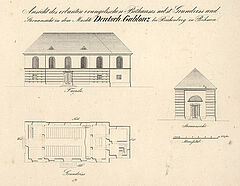
The Czech Province
Today's Czech Province of the Moravian Church was formally admitted to the ranks of the independent provinces at the General Synod in Bethlehem in 1957. However, the actual work "in the land of the fathers" began almost 100 years earlier, after Emperor Franz Joseph I issued the so-called Protestant Patent in 1861, which regulated the legal equality of the Protestant churches and the Catholic Church. The following year, the German Provincial Synod decided to support the already existing Protestant congregations in Bohemia and Moravia and founded a committee (Böhmisch-Mährisches Komitee) to coordinate the new work. The General Synod of 1869 recognised the importance as well as the idealistic side of this project and declared it a common work of the whole Unity.
The written documents are essentially divided into two groups: the older files up to about 1900 are in the record group R.9.D of the Unity Elders’ Conference , while the more recent files (up to 1936) are in the group entitled "Böhmisch-Mährisches Komitee" (BMK). Interesting supplementary documents may be found in the Topographical Collection (TS), which contains illustrations, maps, and plans, and in the collection of photographs. All these record groups (except the collection of photographs) can be researched using our online searching aids: www.unitaetsarchiv.findbuch.net.
The Province Eastern West Indies
The Moravian Church on Saint Thomas, Saint Croix and Saint John
The mission of the Moravian Church began just 10 years after the founding of Herrnhut with a courageous decision and the journey of Leonhard Dober and David Nitschmann to the Caribbean in 1732. Their destination was the island of Saint Thomas, where the foundation stone for the following international missionary work of the Moravian Church was laid. At that time the three islands formed the Danish colony of the Danish West Indies, today they belong to the United States of America as the American Virgin Islands. The congregations of the Moravian Church on the islands, however, are part of the Eastern West Indies Province. The Unity Archives' records concerning the three islands for the period 1731-1900 are in the inventory of the Mission-Department of the Unity Elder's Conference (record group R.15.B), while records for the period 1900-1931 are in the inventory of the Mission-Direction (record group MD - Eastern West Indies). Records pertaining to financial management are in the record group MDF. The record groups contain the historically significant documents from the beginning, for example Leonhard Dober's written declaration to travel to Saint Thomas, or Nitschmann and Dober's diaries and letters from their journey and stay in the Caribbean. In addition to these documents from the early days of the mission, the inventories mainly contain serial files: diaries, minutes, correspondence, annual reports, accounting documents. Among the diaries are the travel diaries of various missionaries and the diaries of the individual mission stations or congregations (such as New Herrnhut und Nisky on Saint Thomas, Friedensberg und Friedensthal on Saint Croix, Emmaus und Bethany on Saint John). A second important group of documents belongs to the library’s manuscript collection (NB.VII.R.2 and 3): translations of biblical and liturgical texts, dictionaries, grammars, and hymn books. Interesting supplementary documents may be found in the Topographical Collection (TS), which contains illustrations, maps, and plans, as well as in the collection of photographs (LBS). All these record groups (except for the collection of photographs and the library) can be researched using our online searching aids: www.unitaetsarchiv.findbuch.net.
The Moravian Church on Antigua
While the Moravian Church on Antigua is today a part of the Eastern West Indies province, the records for Antigua were maintained separately from the other Caribbean islands until 1899. The Unity Archives' records concerning Antigua for the period 1763-1900 are in the inventory of the Mission-Department of the Unity Elder's Conference (record group R.15.D), while records for the period 1900-1931 are in the inventory of the Mission-Direction (record group MD - Eastern West Indies). Records pertaining to financial management are in the record group MDF. In addition to some documents from the early days of the mission in Antigua, the inventories mainly contain serial files: diaries, minutes, correspondence, annual reports, and accounting documents. Among the diaries are those of the individual mission stations or congregations (such as St. John's, Baylyhill, Edgecombhill, Gracehall, Gracebay, Cedarhall, Newfield, Gracefield, Greenbay, Five Islands, Lebanon, and Springgardens), or reports from the teachers' seminary, as well as a number of missionary travel diaries. Interesting supplementary documents may be found in the Topographical Collection (TS), which contains a large number of illustrations, maps, and plans. All these record groups can be researched using our online searching aids.
The Moravian Church on Barbados
Although the Moravian Church on Barbados is today a part of the Eastern West Indies province, the records for Barbados were maintained separately from the other Caribbean islands until 1899. The Unity Archives' records concerning Barbados for the period 1763-1900 are in the inventory of the Mission-Department of the Unity Elder's Conference (record group R.15.E), while records for the period 1900-1931 are in the inventory of the Mission-Direction (record group MD - Eastern West Indies). Records pertaining to financial management are in the record group MDF. Since many missionaries from England worked in Barbados right from the beginning, most of the documents were written in English. The inventories mainly contain serial files: diaries, minutes, correspondence, annual reports, and accounting documents. Among the diaries are those of the individual mission stations or congregations (such as Sharon, Mount Tabor, Bridgetown und Clifton Hill), as well as some missionary travel diaries. Interesting supplementary documents may be found in the Topographical Collection (TS), which contains a large number of illustrations, maps, and plans. All these record groups can be researched using our online searching aids.
The Moravian Church on St. Kitts
While the island of St. Kitts is today a part of the island country Saint Kitts and Nevis and the Moravian Church on it a part of the Eastern West Indies province, the records for St. Kitts were maintained in the Unity Archives in a separate record group (R.15.F). The records for the period 1777-1900 are in the inventory of the Mission-Department of the Unity Elder's Conference, while records for the period 1900-1931 are in the inventory of the Mission-Direction (record group MD - Eastern West Indies). Records pertaining to financial management are in the record group MDF. In addition to some documents from the early days of the mission in St. Kitts, the inventories mainly contain serial files: diaries, minutes, correspondence, annual reports, and accounting documents. Among the diaries are those of the individual mission stations or congregations (such as Zion in Basseterre, Estridge, Bethesda and Bethel). Interesting supplementary documents may be found in the Topographical Collection (TS), which contains a large number of illustrations, maps, and plans. All these record groups can be researched using our online searching aids.
The Moravian Church on Tobago
The island of Tobago belongs to the Lesser Antilles and is now an autonomous island within the Republic of Trinidad and Tobago, while the Moravian Church on it a part of the Eastern West Indies province. Although the Moravian missionaries explored the island for the first time in 1771, only the third attempt from 1827 could establish itself as a permanent work. In 1828 the first mission station was founded, called Montgomery. The records for Tobago were maintained in the Unity Archives in a separate record group (R.15.G.I). The records for the period 1787- 1900 are in the inventory of the Mission-Department of the Unity Elder's Conference, while records for the period 1900-1931 are in the inventory of the Mission-Direction (record group MD - Eastern West Indies). Records pertaining to financial management are in the record group MDF. In addition to some documents from the early days of the mission in Tobago, the inventories mainly contain serial files: diaries, minutes, correspondence, annual reports, and accounting documents. Among the diaries are those of the individual mission stations or congregations (such as Montgomery, Moriah, Bethesda and Spring Garden). Interesting supplementary documents may be found in the Topographical Collection (TS), which contains a small number of illustrations, maps, and plans. All these record groups can be researched using our online searching aids.
The Moravian Church on Trinidad
Like the island of Tobago, the island of Trinidad, as the largest among the Lesser Antilles, is now part of the Republic of Trinidad and Tobago, while the Moravian Church on it a part of the Eastern West Indies province. The work of the Moravian Church began in Trinidad around 1890, as many members had settled on the island, especially from Tobago and Barbados. Although the work was no longer classic missionary work in the strict sense, it was naturally coordinated by the Mission Department of UAC and then by the Mission-Direction. The small, resulting record group was maintained in the Unity Archives in a separate record group. The records for the period 1890-1908 are in the inventory of the Mission-Department of the Unity Elder's Conference (R.15.G.II), while records for the period 1908-1931 are in the inventory of the Mission-Direction (record group MD - Eastern West Indies). Records pertaining to financial management are in the record group MDF. In addition to some documents from the early days of the mission in Trinidad, the inventories mainly contain serial files: diaries, minutes, correspondence, annual reports, and accounting documents. Among the diaries are those of the individual mission stations or congregations (such as Port of Spain, Manantao, Chaguanas, Belmont and L'Anse Noire. All these record groups can be researched using our online searching aids.

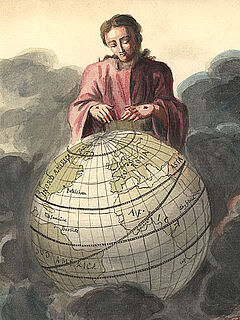
![[Translate to English:] Sitzungssaal der Unitätsältestenkonferenz im Schloss in Berthelsdorf, um 1890, TS.Mp.32.9 [Translate to English:] Sitzungssaal der Unitätsältestenkonferenz im Schloss in Berthelsdorf, um 1890, TS.Mp.32.9](/fileadmin/_processed_/d/2/csm_TS_Mp_32_9_7c740c5ab7.jpg)
